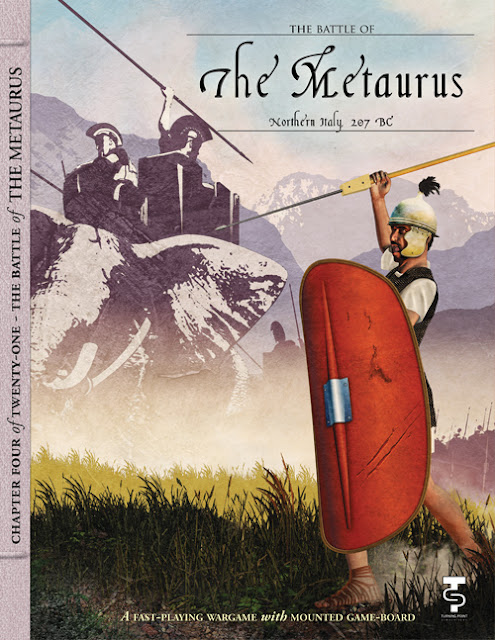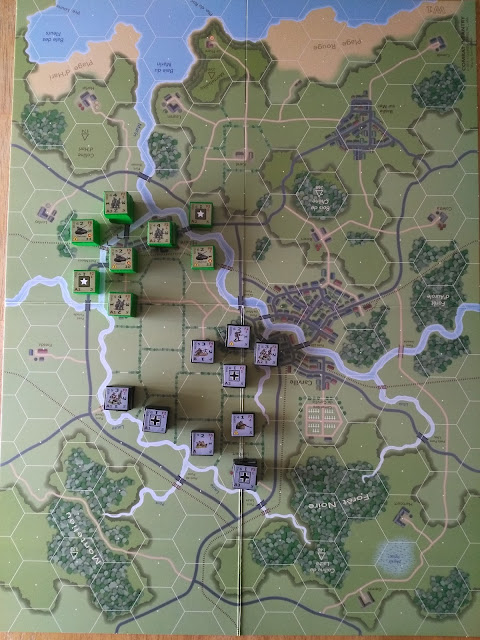V-COMMANDOS: SECRET WEAPONS
If you are unfamiliar with the core game, I'd suggest looking at my original review, before going any further. Otherwise, read on. Perhaps, because V-Commandos up to now has largely been available directly from Triton-Noir, the publishers, it has created limited impact on the gaming scene. This is a great shame, as the quality of production is excellent and I really don't think there is another game out there quite like it. However, I've just received the good news [which you can read here] that it will be imminently available in the UK both through retail outlets and as always directly online.
An initial glimpse inside the box!
If you know the core game or have read my previous review, you'll know that Stealth is the key word and a significant aspect of play. Going in hard with all guns blazing with immediately draw down on you a rush of enemy reinforcements and all too likely failure of your mission.
However, as an expansion, Secret Weapons provides a new set of Operations thematically linked that will bring you more than a fair share of high octane, explosive action this time. This fact jumps out at you as soon as you look at the sections in the Rulebook on Additional Equipment and Special Units. Panzerfausts, mortars and gas barrels do not make for a quiet time!
When you look at the Operations themselves and the buildings related to them the prospect of dramatic action gets even more certain. An airfield and two U-boat bases, along with a V2 rocket site and attempting to guard a stolen V1 rocket until an RAF plane can land to recover it, while blowing up nearby V1 rocket launch ramps as a distraction will truly set alarm bells ringing.
The whole expansion follows exactly the same format as the original base game, which is essential for play. Every facet of the game is added to, starting with three new Commando characters: the Butcher, the Intelligence Officer and the Mortar Gunner. Once again each card that outlines their special abilities and weapons is double-sided with modified or different elements on each. As before, you can judge which side's strengths suits a particular Mission and also adds to the variety of the action. The Mortar Gunner is perhaps the most conventional of the trio and the Intel Officer [the rather femme fatale figure on the box and rule cover] the most original in her specialities.
Though a purely cosmetic detail, I like the touch of signalling the character's nationality by the national flag edging to each card. So, we discover that the Intel Officer is of Polish nationality.
Along with three new characters come three new weapons: two of them, the panzerfaust and the mortar, add a hefty bang to the action, but the third I like even more and that's the smoke grenades and their effect. These add to the signature stealth element of this system as they cause large tiles [where you are always visible] to be treated as small tiles[where you usually are able to remain hidden]; a very simple way of creating the concealing effect of a smoke grenade, though logically one that ought to generate more enemy attention rather than less!
The final new piece of equipment, gas barrels, is not technically a weapon, but once you blow one up it eliminates all units on a tile unless they are wearing gas masks. This point brings us nicely to some of the new enemy units - nine regular German soldiers with gas masks. How convenient! These nine replace nine of the original regular soldiers in the core set. Also added to the German forces are a number of paratroopers, the Fallschirmjagers.
Representing all these items on the playing area are plenty of new tokens, as well as plenty more additions to those already provided in the basic game. In fact, two sheets worth.
In the countersheet above you can see this mix of the old and the new. The latter are the circular counters for gas barrels [marked with skull and cross-bones], panzerfausts and gas grenades, as well as two Goliath-nests for the other special unit, the Goliath - a mini remote-controlled tank packed with explosives. The addition to already familiar counters are the grey oblong open/closed door markers and truck markers that indicate enemy entrance positions, as well as a few +1/-1 Action Tokens.
Beside the counters, there are plenty more Event cards which continue to add more colour and unpredictability to the action too.
Equally impressive are 13 more double-sided tiles for indoor/ outdoor locations.
The set of 13 new tiles on their outdoor side before being pressed out of the sprue.
There are 5 new Operations presented, as before, not by a scenario book, but by a set of highly atmospheric cards, with plenty of sensationally dramatic scenes on them, like this one.
Each Operation's information is supplied by a set of two cards: one card gives the name of the Operation, its date and a map of Europe to locate it geographically.
On the other side is a diagram of the terrains involved in this Operation and how they link up. For those of you unfamiliar with the game, it's important to remember that the word "terrain" is not used of the individual tiles, but to describe a location created from placing a number of tiles. To illustrate what I mean take a look at the next picture, which is the reverse side of the map for Operation Chained Eagle.
Each of the four areas seen above are what the game calls a "terrain", which then has to be created from a choice of tiles. So, the Hangar is assembled following the diagram on the appropriate card, which also gives you information on the actions that have to be taken to complete this element of the Operation.
The other card provides an overview of the Operation.
and its reverse side gives specific supplementary information for added components, actions or restrictions relating to each terrain.
So, here we see that the Commandos at the Hangar get extra equipment, while the Fuel Depot is set up with two reinforcement entrances removed from the terrain and the Test Facility has the awesome information that certain tiles are removed turn by turn to represent the building being swept by fire and any units on those tiles, whether the enemy or your own Commandos, are eliminated!!
However, as you can imagine, creating even one of these terrains takes up several tiles and a fair amount of game space. This is fine for small Operations with only one or two "terrains". But in this expansion, even the three smallest Operations involve three terrain and the other two operations are of four and five terrains respectively.
This can be dealt with by setting up one terrain at a time, completing the action on it and then moving on to construct the next terrain and so on. However, as all five Operations begin with two terrain side by side, but with no ability to move from one terrain to the other, you're far better setting up each of those terrains immediately and playing them in parallel. For realism, this should be how the action is executed.
This last suggestion also leads me to a factor which may influence your decision to add it to your collection. First, I judge that it is very much intended for cooperative play. You really want to be running two teams of Commandos controlled by a minimum of one player for each team. That's not to say that you can't take on even the largest Operation playing solo, but it will take a significant amount of time. The second point really amplifies that last statement; even if you do game with two or more players, be prepared to expend several hours for these are substantial scenarios.
It seems to me that the only reason why you might decide not to take the plunge with this expansion is if you have no access at all to a group happy to play for several hours. Even with my preference for solo play in this type of game, Secret Weapons certainly convinces me that for this game multi-player has its appeal too.
Everything in the package deserves your full attention and appreciation of the quality and the immersive game play. These are richly rewarding, narrative-producing Operations. I can't wait to see what the next expansion, V-Commandos: The Resistance brings.
Once again thanks to Triton-Noir for kindly providing a review copy.




























Follow Us